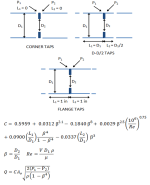Orifice Sizing

Description
ISO 5176 is an international standard that provides guidelines for determining the flow-rate of fluid through orifices, nozzles, and Venturi tubes. The standard specifically deals with the measurement of incompressible fluids, such as liquids, and covers the design, installation, and operating conditions necessary for accurate flow measurement. Here's an overview of the orifice sizing method using ISO 5176:
-
Determine the required flow-rate and operating conditions: Before sizing an orifice, establish the desired flow-rate, operating pressure, temperature, and fluid properties such as density and viscosity. These parameters are essential for accurate orifice sizing and flow measurement.
-
Select the orifice plate type: ISO 5176 specifies various types of orifice plates, such as concentric, eccentric, and segmental orifices. Choose the appropriate orifice plate type based on the fluid characteristics, installation requirements, and measurement accuracy needs.
-
Calculate the orifice diameter: Use the provided equations in ISO 5176 to calculate the orifice diameter based on the desired flow-rate, operating conditions, and fluid properties. The standard offers formulas to determine the orifice diameter for various types of orifice plates and installation configurations. These equations typically involve parameters such as flow-rate, pressure drop across the orifice, fluid density, and pipe diameter.
-
Determine the flow coefficient (discharge coefficient): The flow coefficient, also known as the discharge coefficient, is an essential parameter that accounts for the non-ideal flow conditions, such as fluid turbulence, contraction, and velocity profile distortion. ISO 5176 provides empirical relationships and guidelines to estimate the discharge coefficient for different orifice plates and installation configurations.
-
Verify the Reynolds number and flow conditions: Ensure that the flow conditions satisfy the Reynolds number requirements specified in ISO 5176. The Reynolds number is a dimensionless quantity that characterizes the flow regime (laminar, transitional, or turbulent) and impacts the accuracy of flow measurement. The standard offers minimum and maximum Reynolds number limits for different orifice plate types and configurations to ensure accurate and reliable flow measurement.
-
Confirm the installation requirements: ISO 5176 specifies the installation requirements for orifice plates, such as the minimum straight pipe lengths upstream and downstream of the orifice, positioning of pressure taps, and alignment of the orifice plate within the pipe. Adhering to these requirements is crucial for obtaining accurate flow measurements and minimizing errors due to flow disturbances.
In summary, the orifice sizing method using ISO 5176 involves determining the required flow-rate and operating conditions, selecting the appropriate orifice plate type, calculating the orifice diameter, determining the flow coefficient, verifying the Reynolds number, and confirming the installation requirements. Following these steps and adhering to the guidelines provided by ISO 5176 will help ensure accurate and reliable flow measurement using orifice plates.
Calculation Preview
Full download access to any calculation is available to users with a paid or awarded subscription (XLC Pro).
Subscriptions are free to contributors to the site, alternatively they can be purchased.
Click here for information on subscriptions.



